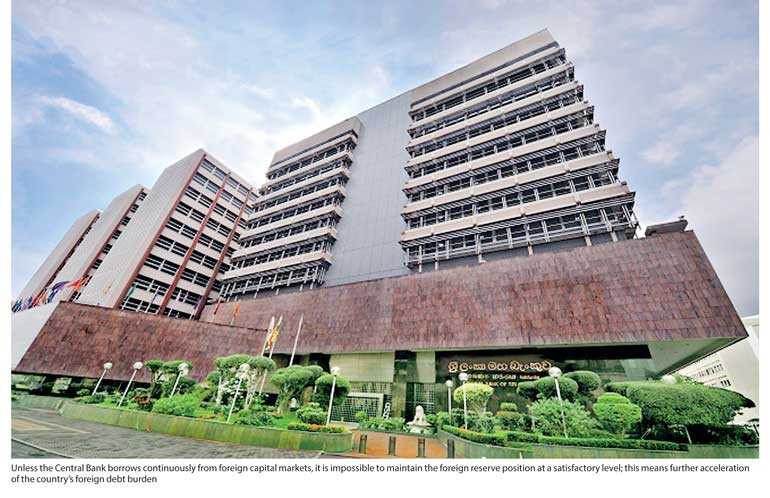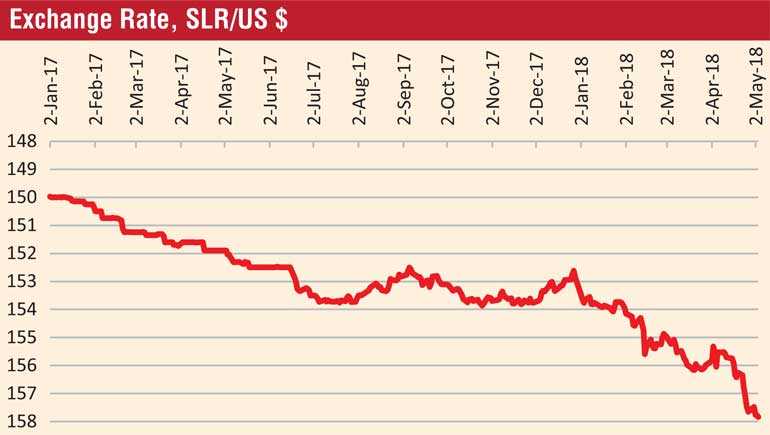Tuesday Dec 23, 2025
Tuesday Dec 23, 2025
Wednesday, 9 May 2018 00:00 - - {{hitsCtrl.values.hits}}


 Sri Lanka is facing harsh external financing vulnerabilities, in contrast to the Central Bank’s recent claims that the country’s gross official foreign reserves have risen to the historically highest level of $ 9.9 billion reflecting improved economic prospects.
Sri Lanka is facing harsh external financing vulnerabilities, in contrast to the Central Bank’s recent claims that the country’s gross official foreign reserves have risen to the historically highest level of $ 9.9 billion reflecting improved economic prospects.
According to a press release issued by the Central Bank last week, oversubscription of the International Sovereign Bond (ISB) amounting to $ 2.5 billion (largest ever), which was offered in April, signals foreign investors’ confidence in Sri Lanka’s economic performance and potential. The Central Bank goes on to say that it has received favourable response from the international community for a proposed term loan of $ 1 billion which is to be utilised by the Government to repay more expensive existing debt.
The affirmative statements issued by the IMF with regard to the country’s economic performance and the better credit ratings given by two international rating agencies are also a reflection of positive foreign sentiments, according to the press release.
As regards the ongoing depreciation of the rupee, the Central Bank authorities are reported to have dismissed the popular “myth” of aggravating foreign debt liabilities by rupee depreciation, and expressed their unwavering capacity to tackle any resulting inflationary pressures through monetary policy.
The above statements indicate that the Central Bank is quite complacent about the economic achievements, particularly on the balance of payments front, and thus, the general public is given the impression that there is no reason to panic.
However, the rapid exchange rate depreciation during the past couple of weeks itself reflects the external finance fragility. Such fast depreciation, of course, is inevitable given the grave balance of payments situation. The depreciation has far reaching repercussions on debt service payments from the viewpoint of fiscal balancing, although the Central Bank denies such adverse effects. The supply-side effects of exchange rate depreciation on inflation and cost of living too are undeniable, and the central bank has limited ability to control such price increases through its demand-side policy tools within the now famous inflation targeting monetary policy framework.
We cannot afford to be too complacent about the unprecedented rise in foreign reserves, as those are nothing but funds borrowed from international capital markets, which are subject to stringent terms and conditions. Oversubscription of the ISB to the tune of 2.6 times is undoubtedly a reflection of the improved foreign sentiments, as claimed by the Central Bank. However, it should be noted that these foreign loans are taken at very high costs to the country. Such market borrowings further enhance the already unsustainable debt stock posing severe debt sustainability risks in the near future, though they may help to ease the present external financing problems and to postpone the inevitable economic reforms.
Private foreign lending institutions are ever ready to disburse sovereign loans to governments in poor countries at premiums favourable to them. Many countries in the regions of Latin America, Africa and Asia have fallen into this debt trap.
The increase in foreign reserves is no reason for complacency, as it is entirely an outcome of borrowings from overseas capital markets, rather than a result of any improvement in the domestic economy. The Central Bank itself admits in its press release that the inflow of recent ISB proceeds is the reason for the rise in international reserves to the peak level. The increase in gross official reserves from $ 7,959 million at the end of 2017 to $ 9,927 million by now is entirely a result of the foreign borrowings raised through the ISB.
Foreign borrowings through an ISB amounting to $ 1.5 billion issued by the Central Bank last year too helped to improve the reserve position previously. It was complemented by a net inflow of Treasury bond proceeds amounting to $ 360 million in 2017. Thus, debt security inflows were the major contributory factor that led to an external financial account surplus of $ 2,068 million in 2017, and the resulting equivalent amount of increase in foreign reserves.
The rise in foreign reserve stock, for whatever reason, is a temporary phenomenon in the current context, as it is going to fall down soon due to the upcoming foreign debt commitments. The net drain on foreign reserves within the next 12 months is estimated to be $ 7.5 billion, of which $ 6.3 billion is for foreign currency loans, securities and deposits, and the balance $ 1.2 billion is for foreign currency forwards and futures.
Hence, unless the Central Bank borrows continuously from foreign capital markets, it is impossible to maintain the foreign reserve position at a satisfactory level. This means further acceleration of the country’s foreign debt burden.
The rupee has depreciated sharply against the US dollar since the beginning of this year, as shown in the chart. The weakening of the currency is largely a reflection of the continuing setback in the external sector characterised by the wide trade gap and heavy external debt commitments. The rupee fell by 3.3% against the dollar this year so far, compared with a drop of 2.5% last year. In April alone, the rupee fell by 1.1% reflecting a sharper depreciation.
Undoubtedly, freer movement of the exchange rate is essential to improve the country’s export competitiveness and to discourage imports so as to reverse the weakening of the balance of payments. Such an exchange rate system is compelling, as the Central Bank is in the process of moving towards an inflation targeting monetary policy framework in which it is not permissible to have a nominal anchor such as the exchange rate or the money supply.
In terms of the Extended Fund Facility (EFF) arrangement with the IMF, the Central Bank is committed to pursuing a flexible exchange rate regime with intervention limited to preventing wide fluctuations and building up official reserves.
The adverse effects of the Central Bank’s previous attempts to defend an overvalued currency on the external sector were clearly evident. Hence, the shift towards a more flexible exchange rate regime is commendable.
Nevertheless, certain statements issued by the high-ranking Central Bank officials few days ago with regard to the rupee depreciation tend to mislead the public. They have dismissed the “myth” of aggravating foreign debt liabilities by rupee depreciation. They also defended the rupee fall on the grounds of their ability to intervene in the foreign exchange market at any time due to the strong foreign reserve position. They further claim that any inflationary pressures arising from the rupee depreciation could be tackled by adjusting their policy (interest) rates.
The effects of currency depreciation on foreign debt burden are well known. Although the depreciation does not cause any rise in the foreign debt stock in US dollar terms as claimed by the Central Bank, the external debt stock as well as its service costs in rupee terms go up proportionately to the depreciation causing severe burden on fiscal operations. The rupee depreciation resulted in a rise in the foreign debt stock by a staggering Rs. 225.2 billion at the end of 2017, according to the Central Bank’s latest Annual Report. This year’s depreciation to date has led to increase the foreign debt stock further by around Rs. 155 billion.
The main reason for the rise in foreign debt is the financing of budget deficit through foreign sources, mainly commercial borrowings. As a result of these continuous foreign borrowings, the debt service payments have bunched heavily at present costing the government a whopping US $ 17.8 billion during the period 2018-2022; $ 2.8 billion 2018, $ 4.2 billion in 2019, 3.7 billion in 2020, $ 3.3 billion in 2021 and $ 3.7 billion in 2022.
In rupee terms, the external debt service payments for this year is likely to go up by over Rs. 14 billion as a result of the exchange rate depreciation that took place to date. These costs will increase further during the rest of the year depending on the extent of depreciation.
The country’s external sector is in a dismal state. The trade deficit widened from $ 8.9 billion in 2016 to $ 9.6 billion in 2017. The rapid increase in imports outpaced the slower export growth. The export sector, which still depends largely on garments and commodity exports, has failed to increase its share in the global market with innovative, knowledge-based, high-tech products, unlike in the fast-growing neighbouring countries. In contrast, imports rise at a faster pace calling for monetary policy tightening.
The larger surplus generated in the services account in 2017, which was due to increased earnings from transport and tourism, was inadequate to offset the negative impact of the huge trade deficit on the balance of payments. The situation is being worsened by a slowdown of worker remittances due to unsettled conditions in the Middle East countries.
Overall, the current account recorded a deficit of $ 2.3 billion amounting to 2.6 percent of GDP in 2017. This had to be financed mainly through foreign borrowings consisted of Sovereign Bonds, Treasury Bonds and long-term loans. In the absence of dynamism in the export sector and the weak macroeconomic fundamentals which hinder foreign direct investments, the balance of payments situation is unlikely to improve in the near future.
The rupee depreciation obviously has had cost-push effects on import prices and consequently on domestic consumer prices. This process is usually measured through the ‘exchange rate pass-though’, defined as the effect of exchange rate changes on domestic inflation.
Evidently, rupee depreciation has varying upward effects on both wholesale and consumer prices with the maximum effect occurring in the second month of the shock on wholesale prices and between the second and the third month on consumer prices. Around 25 percent of the variation in consumer price inflation could be explained by external shocks including exchange rate, oil price and import price shocks.
The initial round of inflationary effects of the rupee depreciation is already evident with the recent price increases in milk powder, LP gas and fuel. Inflation is likely to escalate further in the coming months owing to the currency depreciation. Needless to say, that high inflation has adverse spill-over effects on the living standards of the poor and lower middle-income class families.
The country’s GDP growth rate slumped to 3.1% in 2017 – the lowest since 2001 – reflecting the economic downturn. The growth prospects are severely constrained by the balance of payments difficulties discussed in this article. The increasing debt burden has adverse effects on both the external and fiscal sectors. The country does not have the capacity to repay its foreign loans, and therefore, maturing debt has to be rolled over into new debt posing painful rollover risks in the coming years.
In the meantime, the ongoing rupee depreciation resulting from the weak external finances exerts adverse effects on the cost of living, debt burden and many other economic variables.
Amidst this precarious economic plight, the Government is preoccupied with its own political agendas such as strengthening the political parties, frequent Cabinet reshuffles and cross-overs. In the circumstances, adequate attention is not given to tackle the current economic crisis. The current political instability has disastrous effects on the country’s international image discouraging prospective foreign investors.
The Government is engaged in fire-fighting exercises to tackle the day-to-day problems rather than addressing the underlying economic disarrays with comprehensive economic strategies from a long-term perspective. The Vision 2025 launched with grand fanfare not so long ago seems to be side-tracked as in the case of previous economic policy statements. In any case, all those policy documents contained only wish-lists rather than any pragmatic macroeconomic policy frameworks that are geared to resuscitate the falling economy.
In this context, the Central Bank has the leading role to play in rectifying the disarrays in macroeconomic fundamentals, rather than consoling itself with the success of foreign loan mobilisation.
(The writer is Emeritus Professor of Economics, Open University of
Sri Lanka.)